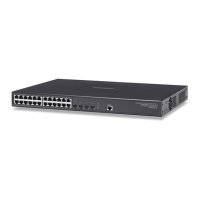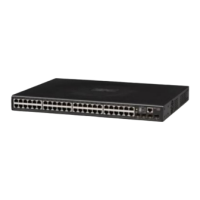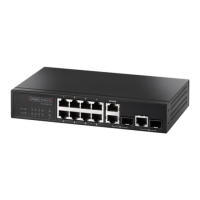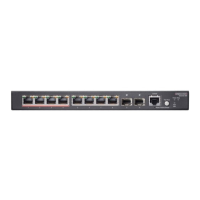C
HAPTER
4
| Configuring the Switch
IEEE 802.1Q VLANs
– 102 –
VLANs help to simplify network management by allowing you to move
devices to a new VLAN without having to change any physical connections.
VLANs can be easily organized to reflect departmental groups (such as
Marketing or R&D), usage groups (such as e-mail), or multicast groups
(used for multimedia applications such as videoconferencing).
VLANs provide greater network efficiency by reducing broadcast traffic, and
allow you to make network changes without having to update IP addresses
or IP subnets. VLANs inherently provide a high level of network security
since traffic must pass through a configured Layer 3 link to reach a
different VLAN.
This switch supports the following VLAN features:
◆ Up to 256 VLANs based on the IEEE 802.1Q standard
◆ Distributed VLAN learning across multiple switches using explicit or
implicit tagging
◆ Port overlapping, allowing a port to participate in multiple VLANs
◆ End stations can belong to multiple VLANs
◆ Passing traffic between VLAN-aware and VLAN-unaware devices
◆ Priority tagging
Assigning Ports to VLANs
Before enabling VLANs for the switch, you must first assign each port to
the VLAN group(s) in which it will participate. By default all ports are
assigned to VLAN 1 as untagged ports. Add a port as a tagged port if you
want it to carry traffic for one or more VLANs, and any intermediate
network devices or the host at the other end of the connection supports
VLANs. Then assign ports on the other VLAN-aware network devices along
the path that will carry this traffic to the same VLAN(s), either manually or
dynamically using GVRP. However, if you want a port on this switch to
participate in one or more VLANs, but none of the intermediate network
devices nor the host at the other end of the connection supports VLANs,
then you should add this port to the VLAN as an untagged port.
ASSIGNING PORTS TO
VLANS
To enable VLANs for this switch, assign each port to the VLAN group(s) in
which it will participate.
PARAMETERS
The following parameters are displayed on the VLAN Membership
Configuration page:
◆ VLAN ID - VLAN Identifier. (Range: 1-4095)
◆ Port Members - Port identifier.
Port overlapping can be used to allow access to commonly shared
network resources among different VLAN groups, such as file servers or
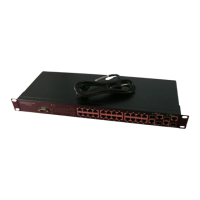
